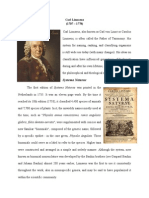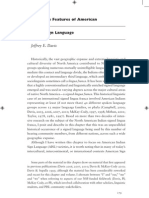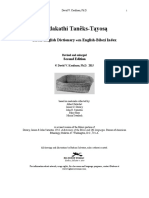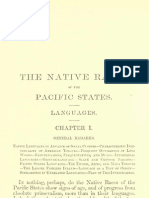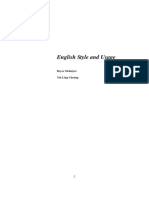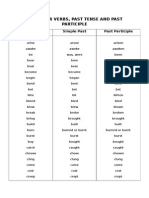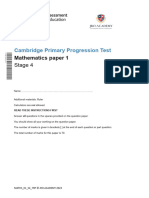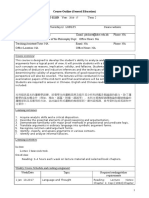Language Death Notes
Language Death Notes
Uploaded by
Gusni DarianiCopyright:
Available Formats
Language Death Notes
Language Death Notes
Uploaded by
Gusni DarianiOriginal Title
Copyright
Available Formats
Share this document
Did you find this document useful?
Is this content inappropriate?
Copyright:
Available Formats
Language Death Notes
Language Death Notes
Uploaded by
Gusni DarianiCopyright:
Available Formats
Notes for LG102, Intro Sociolinguistics University of Essex, Prof. Peter L.
Patrick Week 18, Winter term
Language Shift, Language Death and Language Rights
These notes briefly introduce some key concepts of language shift and loss leading to language death. Language death inevitably brings up issues of linguistic human rights, since it typically occurs in situations of cultural pressure, including but not limited to discrimination against linguistic minorities. I wont try to address linguistic human rights (LHR) here, but rather link you to another introductory page I have created on this topic. Please also see other links at the bottom of this page, and readings from the coursepage. Language shift: when a community who share a native language abandon it, and collectively shift to speaking another one instead. o This goes also for dialect: dialect shift is a case of language shift. Language shift is always preceded by multilingualism: you cant shift to a new language unless you learn to speak it. o But societal multilingualism does not always lead immediately to language shift: it can be a stable condition. Two kinds of questions structural and social can be asked about language shift by sociolinguists: o What effects does language shift have on the structures of the languages involved? On the structure of the target language (L2, the language being shifted to)? On the structure of the source language (L1, the language being shifted away from)? o What information (social, linguistic, cultural) is needed in order to predict language shift? Language shift can happen rapidly or slowly. o Caribbean Creole languages developed within a century, even less, from African and European languages. Most African languages were lost in 1-2 generations under the catastrophic conditions of slavery, though traces of a few remained for 350 years until the late 20th C.
o Scots Gaelic was outlawed in Scotland after the 1745 Jacobite rebellion (when the Scots with Charles Stuart invaded England). Its been in decline ever since. o The numbers of bilingual speakers (when a language is in later stages of slow decline, this number is typically larger than the number of people who remain monolingual speakers of it) show this: Year 1831 1931 1991 Number of Scotland c. 136, c. 81, c. 66, bilingual Gaelic/English speakers, 000 000 000
(These figures & the next set dont quite square up both represent educated guesses in the early years)
o Gaelic allowed back in some schools in 1918, revived since 1958. Survives today mainly in religion, folklore and folk medicine, traditional occupations (farming, fishing, crafts), storytelling & singing.
Numbers of monolingual Gaelic speakers and Gaelic/English bilinguals, Scotland, 1806 to 2001
Year 1806 1808 1881 1891 1901 1911 1921 1931 1951 1961 1971 1981 1991 2001 Total numbe r of speakers 297 823 289 798 231 594 210 677 202 700 183 998 148 950 129 419 93 269 80 978 88 892 79 307 65 978 58 652 Number of monolingual speakers No data No data No data 43 738 28 106 18 400 9 829 6 716 2 178 974 477 No data No data No data Combined share in population, Scotland 18,5% 22,9% 6,2% 6,3% 5,1% 4,3% 3,5% 2,9% 2,2% 1,5% 1,7% 1,6% 1,35% 1,2% (from Skutnabb-Kangas 2005, #8)
Language shift is not a new phenomenon. It has been going on for all of recorded history. Whenever two cultures/populations with different languages come in intense contact, shift is a possibility. o Typically those who shift are the weaker group, but
o sometimes it is the more powerful one who shifts.
The Anglo-Saxons and Vikings: Case study of Language Shift
Around 450 AD, the Anglo-Saxons followed the Romans who had left very little spoken or written Latin in the wild illiterate country of Britain. The Vikings, who spoke older forms of Norwegian and Danish, invaded parts of the British Isles (and N France) later, from c. 787 AD on. The Normans, descended from Vikings in France, came still later: 1066. o (Launch BBC The Ages of English timeline well use only Acts 1-2-3) www.bbc.co.uk/history/british/launch_tl_ages_english.s html
Act 1: The Anglo-Saxons
The Romans are gone not much Latin spoken when the Angles, Saxons and Jutes arrive. o (click on the Shield in Act I for background to the narrative) They bring their own vernacular, which competes with the native Celtic languages. They also bring missionaries, c.600 AD, with writing and a strong Latin tradition o which gets used to spell & write Anglo-Saxon words. (click on the Globe in Act I for overview of writing) o So besides vernacular borrowing from Latin, higher, literate forms emerge too o (click on the Bomb to see exs. of both everyday and religious borrowings) o (click on the Microphone to hear and see an excerpt from Beowulf in Old English, and o ...to view an illustration of the script used by scribes of the day). Also try the Joker and the Bottle in this and other Acts for various panels of info.
Act 2: The Danes/Vikings come
They arrive in c.787, speaking Old Norse, and defeat the AngloSaxons. o (Click on the Shield make sure youve gone to Act 2! for the Danelaw, and the ups and downs of conflict between the Vikings and Anglo-Saxons) This map shows the main routes taken and areas settled in the British Isles and Ireland o www.bbc.co.uk/schools/vikings/invasion/index.shtml Both speak similar Germanic languages: o West Germanic for Anglo-Saxons, North Germanic for the Vikings. o Find both on the family tree of Indo-European (note that it favours English! & doesnt show all members) Words for everyday items in Old Norse replaced similar ones in Old English, so we can see how closely they lived together o unlike the divide between Latin- or French-speakers and English-speakers in Act 3. (The Globe discusses Scandinavian influence on placeand person-names) (The Bomb gives exs. of the many ordinary words borrowed in this process) In Britain the Vikings were strongest in those areas that retain Celtic languages today: o Ireland, the Western Isles and the North of Scotland but also in the North of England. o This map shows the general extent of Scandinavian placenames in the Danelaw: http://www.viking.no/e/england/danelaw/ekartdanelaw.htm o This one shows individual spots around York, or Jorvik as it was then known (red J, bottom right): www.viking.no/e/england/york/scan_settlements_in_jorv ik_m.html (The Joker plays and shows an insult from the Battle of Maldon, nearby in Essex.) (This link gives another version of the same lines, plus pictures, and discusses the Battle between the Viking leader Sweyn Forkbeard, son of King Harald Bluetooth, and English Byrhtno.) The Vikings kept their language for centuries, then shifted to and influenced the evolving English language.
Act 3: The Normans
The Vikings also went to northern coastal France, as this map shows: http://www.viking.no/e/france/place_name_map.html o where they eventually became bilingual & then shifted to French Normans < Norse-men (= North-men). They brought Norman French when they (with their leader William) conquered England in 1066. It remained the court language for 400 years, influencing English. o Norman French was a vernacular spoken language, but also a language of power William the Conqueror named French-speakers to top posts. (The Shield describes these developments) o Latin is the Church language, a high literate variety. So a few people (churchmen) may have been trilingual, though more often people would have been bilingual: Fr/En, or La/Fr. o Words from both Latin & French came into English, though at a high-status level (The Bomb gives exs. of such borrowed words from domains of power and might) o So, a very different kind of borrowing from what happened earlier with Anglo-Saxon and Old Norse. A more detailed comparison of the two borrowing patterns is given here: http://www.bbc.co.uk/history/trail/conquest/afte r_viking/legacy_vikings_04.shtml These Norman invaders soon became bilingual, and ultimately monolingual, speakers of English, shifting yet again. Of course, o Those who stayed in France remained monolingual speakers of French, not learning English, and o The Vikings who stayed in Scandinavia remained speakers of N Germanic languages, which evolved into modern Norwegian, Danish, etc. o So there was no language death for the Vikings original languages they continued to be spoken, passed on, and evolve.
End of Case Study
Case Study of Language Shift: Chinook (Jargon)
o See ChinookCase.htm
Language Death
Language shift leading to language death is the problem nowadays. Language death is the extreme case: the complete disappearance of a language. o Most commonly a gradual process spanning several generations. o Sometimes a result of genocide, the sudden elimination of an entire population.
Example of language death by genocide: Australian Aboriginal languages
o Over 350 languages were spoken when Capt. Cook landed in 1770 perhaps twice that number!. o 200 years later, only 90 survived as viable languages. 70 of those are threatened by extinction in the near future. Something is known of another 100 or so. o Only 10% of Aboriginal people still speak native languages. o Only 8 languages have more than 1,000 speakers 45 languages have only 10 to 100 speakers not enough to ensure survival. o Wikipedia has a decent overview of the languages: o http://en.wikipedia.org/wiki/Australian_Aboriginal_language s o More information on Western Australian languages near the Kimberley region (discussed in Week 17): o http://coombs.anu.edu.au/WWWVLPages/AborigPages/LAN G/WA/contents.htm
Example of language death by genocide: Tasmania
Tasmania was first contacted by the Dutch captain Abel Tasman in 1642, later sighted by Capt. Cook (1777), and settled by the English in 1803.
The unique native population of about 8,000 people lived there for 35,000 years. The sea rose 10,000 years ago and cut them off from Australia. This map (enlarge) shows the distribution of native groups on first European contact: http://en.wikipedia.org/wiki/Tasmanian_Aborigine They spoke c. 10 distinct languages, and lived in groups of c. 40-50. Between 1802-1833, disease and genocide by English settlers reduced this population to about 300, less than 4%. o By 1832 the last free Tasmanians were put in a concentration camp by the British, while fugitives were killed for sport by bounty hunters. Of the 300 resettled, 250 had died by 1847. By 1876 all had died, except for cases of intermarriage. o Only place and people names remain of the Tasmanian language today. However, some 10,000 people may have Aboriginal Tasmanian heritage, mostly by descent from two women who had children with European men.
Linguistic genocide = Linguicide
See definition at TerraLingua by Tove Skutnabb-Kangas Sometimes too, massive killing takes place but survivors remain, o who feel forced to abandon their language/culture because it is dangerous to be identifiable as a group member. o Several languages once spoken in El Salvador & Honduras fit this category Cacaopera, Pipil, Lenca. o The indigenous speakers were persecuted and killed by death squads.
Tove Skutnabb-Kangas presentation on Linguistic and Cultural Genocide
The following points refer to specific slides from the powerpoint presentation above, made as part of the Annual Lecture Series on Language and Human Rights at Essex in Nov 2005. Speaker Tove Skutnabb-Kangas addressed the topic of (Linguistic and cultural) Genocide in education signals lack of Linguistic Human Rights But
why no discussion?" The entire presentation can be seen online here. The numbers below select specific slides to illustrate the points of this LG102 lecture go to the PPT file and go to that slide number. Or read the whole thing! 1-3: Intro, themes Illustrations of language loss: o 6-7: Sweetgrass Nation in Ontario, Canada o 8: Decline of Gaelic speakers in Scotland o 10-11: Which languages survive? o 12, 14: Necessity for LHR for language protection. o 20: Size of speech communities o 23: Demographic dominance of a few languages o 27-28: Predictions for the near future Language Death vs Language Murder: o 32-35: Which paradigm? o 36-39: Killer languages defined o 42, 46, 49: Linguistic genocide o 68-70: But is it intentional? Indian Schools in Canada: o 76-77, 80: Children were forcibly assimilated, o 85-6-7-8-89: Using schools to eliminate culture & language. o 121: Most minority & indigenous participates in committing linguicide. Further examples of language death by genocide: It o North American Indian (ie Native American) languages spoken in the USA: http://www.ncela.gwu.edu/expert/faq/20natlang.html lists languages w/estimates of speakers 1. Table by name (see Chinook, Chehalis) 2. Table by number (Navajo vs everything else) o See MLA Map of Language Diversity in the USA at http://www.mla.org/map_single Select Other Native North American Languages (other than Navajo), and update o Darin Howe and Eung-Do Cooks survey article Canadian Native Languages.pdf documents the numbers of Aboriginal languages above the US border See map, p3 note Salish, Athabaskan languages we spoke about in the Chinook (Jkargon) case.
works.
Dialect loss and death
o A similar problem, similar causes, but because of language standardization, even fewer people respect dialects and local cultures. School and university, and social/geographic mobility, are the main culprits here. England is a dialect-hostile nation, probably because of its historical investment in Standard English. 1994: Minister for education (Tory govt.) announced that all children should speak Standard English. Also linguaphobic: decline in Foreign Language study, year on year; statement by Minister for Home Affairs that all immigrants should learn and speak in English rather than native languages.
Explanations and Solutions
Reasons for decline of languages/cultures worldwide (Brenzinger 1997) Main one: attitudes, both internal and external, reinforced/caused by Contrasts in power/status/economic opportunity b/w speakers of A and B Main vehicle is schools and higher education, supported by mass media. o See below for list of factors thought to promote or retard language death. o Whats needed is not a subtractive approach to multilingualism: I.e., To learn a new (e.g. standard) language you have to stop using an old one (dialect or immigrant language) o ...But an additive approach: Multilingual maintenance is easily possible given positive attitudes and proper instruction. o Schools should help in the learning of national standard varieties, but not seek to denigrate or replace dialects or minority languages. o The solution to discrimination (racism, sexism) is not to become like the majority this is equally true for language. Attack discrimination, not dialects/languages.
Multilingualism and Language Shift and Death: Summary
Multilingualism is always present before cases of gradual language death. o Movement from language-choice-by-audience
to language-choice-by-context o is a pretty good predictor of shift. o As long as people have certain individuals to whom they habitually use a minority language, it is unlikely to be lost. o When the situation changes such that they code-switch in some contexts, to all speakers, shift appears to be inevitable. Language shift and death is typically focused on as a minoritylanguage phenomenon, o though the processes dont only work that way.
Three schooling/policy approaches:
1. Stamp out nonstandard dialects/minority languages. Psychologically, socially and morally wrong, and hopefully impossible. 2. Teach bidialectalism in standard/non-standard codes, and encourage code-switching into the standard when it is considered socially appropriate. Only works for speaking, not writing, and even then, Only when people want to and can assimilate and It doesnt change prejudices. 3. Teach linguistic tolerance instead of promoting standard languages. Then you dont have to change anyones speech, just social attitudes
More Online Materials:
More on the language situation in Papua New Guinea we encountered last week (teaching notes by ML Landweer): See coursepage under Week 17. o Size: is there safety in numbers? o Multilingualism as the norm in Papua New Guinea o What factors act as safe-guards in the case of some PNG small languages? o What factors can help to predict language maintenance or language death (=ethnolinguistic vitality)? o Foundation for Endangered Languages: http://www.ogmios.org/ o Linguistic Society of America, 1995 statement on Language Rights: www.lsadc.org/ (see the site map) o Links on Tasmanian history and indigenous culture:
o www.tasmanianaboriginal.com.au/index.htm History links from a Tasmanian Aboriginal organisation. o www.justpacific.com/tasmania/first.html Summary of Tasmanian history: early contacts with Europeans o More on Native American and Heritage Languages in the USA at http://www.ncela.gwu.edu/resabout/culture/ o My page on Linguistic Human Rights: A sociolinguistic introduction (2005): o http://privatewww.essex.ac.uk/~patrickp/lhr/linguistichumanright s.htm
You might also like
- The Meaning of Ouch and OopsDocument18 pagesThe Meaning of Ouch and Oopsjr1234No ratings yet
- Smith and Hall - A Copious and Critical English Latin DictionaryDocument1,037 pagesSmith and Hall - A Copious and Critical English Latin Dictionaryanthos_nouNo ratings yet
- An Introduction To The Study of Old High German 1000007005Document277 pagesAn Introduction To The Study of Old High German 1000007005DNo ratings yet
- Carl Linnaeus (Print)Document3 pagesCarl Linnaeus (Print)Liwen LiewNo ratings yet
- 5 Celts and TeutonsDocument5 pages5 Celts and TeutonsJulian GalvisNo ratings yet
- Indian NotebooksDocument140 pagesIndian NotebooksAnargyros DeniososNo ratings yet
- William T. Alexander - History of The Colored Race in America (1887)Document646 pagesWilliam T. Alexander - History of The Colored Race in America (1887)chyoungNo ratings yet
- Discourse Features of American Indian Sign LanguageDocument39 pagesDiscourse Features of American Indian Sign LanguagepislprojectNo ratings yet
- Chambers S Etymological Dictionary of THDocument611 pagesChambers S Etymological Dictionary of THJp NguyenNo ratings yet
- Written Arabic An Approach To The Basic StructuresDocument62 pagesWritten Arabic An Approach To The Basic StructuresMuhammad YusofNo ratings yet
- Translation StudiesDocument43 pagesTranslation Studiesibrahim khan100% (1)
- A Dictionary of English EtymologyDocument829 pagesA Dictionary of English EtymologyReed Burkhart100% (1)
- A Dictionary of The Biloxi and Ofo Languages 1912Document354 pagesA Dictionary of The Biloxi and Ofo Languages 1912Jorge Mora100% (1)
- Biloxi-English Dictionary Second Edition PDFDocument230 pagesBiloxi-English Dictionary Second Edition PDFEmil Agayev100% (1)
- Foreign Influences On Old English. (Baugh and Cable: A History of The English Language. Chapter 4)Document67 pagesForeign Influences On Old English. (Baugh and Cable: A History of The English Language. Chapter 4)MichaelAmoryNo ratings yet
- The Monroe DoctrineDocument21 pagesThe Monroe DoctrineAditya RoyNo ratings yet
- Latin Phrases2Document115 pagesLatin Phrases2Jose Luis HuizarNo ratings yet
- Silverstein - The Culture of Language in Chinookan Narrative Texts Or, On Saying That ... in ChinookDocument20 pagesSilverstein - The Culture of Language in Chinookan Narrative Texts Or, On Saying That ... in ChinookadamzeroNo ratings yet
- Word Grouping and MorphologyDocument8 pagesWord Grouping and Morphologyernie09100% (1)
- NRv03 Lang01Document23 pagesNRv03 Lang01Russell HartillNo ratings yet
- OghamDocument7 pagesOghamuomomedicina.itNo ratings yet
- Britain and Barbary 1589 1689. Nabil MatarDocument257 pagesBritain and Barbary 1589 1689. Nabil Matardevientart.me100% (1)
- A Comprehensive Etymological Dictionary of the Spanish Language with Families of Words based on Indo-European Roots: Volume II (H - Z and Appendix)From EverandA Comprehensive Etymological Dictionary of the Spanish Language with Families of Words based on Indo-European Roots: Volume II (H - Z and Appendix)No ratings yet
- An English-Latin GradusDocument456 pagesAn English-Latin GradusG Heap100% (1)
- Sources DictionariesDocument13 pagesSources DictionariesAhmad Alkassar100% (1)
- 5-Morphological Study of Verb Anglicisms in Spanish Computer Language PDFDocument5 pages5-Morphological Study of Verb Anglicisms in Spanish Computer Language PDFAnna84_84100% (1)
- Department of English and American StudiesDocument77 pagesDepartment of English and American StudiesmannieNo ratings yet
- Cornelia - Mima Maxey (1933) PDFDocument97 pagesCornelia - Mima Maxey (1933) PDFHemerson Luan0% (1)
- The Aborigines and The Colonists by Edward Eggleston in The Century Magazine May 1883Document20 pagesThe Aborigines and The Colonists by Edward Eggleston in The Century Magazine May 1883Marques YoungNo ratings yet
- Legal Latin DictionaryDocument144 pagesLegal Latin DictionaryAnonymous bvdpWaNo ratings yet
- A Complete Grammar of Esperanto - Kellerman, IvyDocument384 pagesA Complete Grammar of Esperanto - Kellerman, Ivyjeralolu44100% (1)
- Spanish WordlistDocument48 pagesSpanish WordlistMaca50% (2)
- The Vice-Admiralty Courts and the American RevolutionFrom EverandThe Vice-Admiralty Courts and the American RevolutionRating: 2 out of 5 stars2/5 (1)
- OccidentalCourseIn10Lessons EnglishTranslationDocument92 pagesOccidentalCourseIn10Lessons EnglishTranslationTortura ChinaNo ratings yet
- MoroccoDocument12 pagesMoroccoEssihi Dhj100% (1)
- Assyrian Primer, An Inductive Method of Learning The Cuneiform CharactersDocument62 pagesAssyrian Primer, An Inductive Method of Learning The Cuneiform Charactersnatzucow100% (1)
- Sweet-The Iberian Roots of American Racist ThoughtDocument25 pagesSweet-The Iberian Roots of American Racist ThoughtClóvis PadilhaNo ratings yet
- Vocabulario Lenca PDFDocument36 pagesVocabulario Lenca PDFJared CanalesNo ratings yet
- English Style and UsageDocument139 pagesEnglish Style and UsagethitpNo ratings yet
- Formal and Informal LatinDocument6 pagesFormal and Informal LatinMr MrNo ratings yet
- Grammar: PDF Generated At: Sun, 12 Aug 2012 13:23:53 UTCDocument34 pagesGrammar: PDF Generated At: Sun, 12 Aug 2012 13:23:53 UTCSri Krishna Kumar0% (1)
- Indian Linguistic Families Of America, North Of Mexico Seventh Annual Report of the Bureau of Ethnology to the Secretary of the Smithsonian Institution, 1885-1886, Government Printing Office, Washington, 1891, pages 1-142From EverandIndian Linguistic Families Of America, North Of Mexico Seventh Annual Report of the Bureau of Ethnology to the Secretary of the Smithsonian Institution, 1885-1886, Government Printing Office, Washington, 1891, pages 1-142No ratings yet
- English Dictionaries As Cultural Mines - Roberta FacchinettiDocument270 pagesEnglish Dictionaries As Cultural Mines - Roberta FacchinettiPenélope MirandaNo ratings yet
- Lecture - 10. Phonetics LectureDocument78 pagesLecture - 10. Phonetics LectureMd Abu Kawser SajibNo ratings yet
- Genetics Mass Media Identity 2006Document158 pagesGenetics Mass Media Identity 2006ZlatanMuslimovićNo ratings yet
- Language and DialectDocument82 pagesLanguage and DialectAhmetNo ratings yet
- Who Translated The Bible in English and Was The Significant?Document6 pagesWho Translated The Bible in English and Was The Significant?Anonymous E27HifJxENo ratings yet
- The Wild: Which Employ Some Ex The ExDocument69 pagesThe Wild: Which Employ Some Ex The ExRussell Hartill100% (1)
- Rick Hill - Fort Niagara Treaty of 1764 FinalDocument30 pagesRick Hill - Fort Niagara Treaty of 1764 FinalRussell DiaboNo ratings yet
- Juan de Tovar PDFDocument4 pagesJuan de Tovar PDFTörök Levente BélaNo ratings yet
- Dirrscolloquiale 00 DirrrichDocument184 pagesDirrscolloquiale 00 DirrrichactonitNo ratings yet
- Toward the Meeting of the Waters: Currents in the Civil Rights Movement of South Carolina during the Twentieth CenturyFrom EverandToward the Meeting of the Waters: Currents in the Civil Rights Movement of South Carolina during the Twentieth CenturyWinfred B. Moore, Jr.No ratings yet
- Race As A ClassDocument6 pagesRace As A ClassTim DoNo ratings yet
- Conquest of The Americas (Eakin-2002)Document81 pagesConquest of The Americas (Eakin-2002)GregNo ratings yet
- Mas Ūdī HistoriographyDocument222 pagesMas Ūdī HistoriographyTsanarNo ratings yet
- Barnes Kahn Essays On BeingDocument4 pagesBarnes Kahn Essays On BeingDerek van Zoonen0% (1)
- On the Laws and Customs of England: Essays in Honor of Samuel E. ThorneFrom EverandOn the Laws and Customs of England: Essays in Honor of Samuel E. ThorneNo ratings yet
- A Different Perspective: The Traveler's Guide to Medieval (Islamic) Spain and PortugalFrom EverandA Different Perspective: The Traveler's Guide to Medieval (Islamic) Spain and PortugalNo ratings yet
- EAPP Notes Lesson 1 8Document13 pagesEAPP Notes Lesson 1 8dwyquishNo ratings yet
- Midterm Module For EnglishDocument42 pagesMidterm Module For EnglishMarie ShaneNo ratings yet
- Spring 2023 Popular Culture Project Assignment Sheet & RubricDocument4 pagesSpring 2023 Popular Culture Project Assignment Sheet & RubricAshley BeardsleyNo ratings yet
- SpinDocument6 pagesSpinCélio LimaNo ratings yet
- Preposition3qtr COTDocument6 pagesPreposition3qtr COTBloom SarinasNo ratings yet
- Irregular Verbs, Past Tense and Past ParticipleDocument6 pagesIrregular Verbs, Past Tense and Past ParticipleSubathara Pindaya100% (2)
- Stage 4 2023 Cambridge Primary Progression Paper 1 Mathematics JRO AcademhyDocument8 pagesStage 4 2023 Cambridge Primary Progression Paper 1 Mathematics JRO Academhy우리100% (1)
- H 9 Adjectives and AdverbsDocument6 pagesH 9 Adjectives and AdverbsRodrigoNo ratings yet
- 6 - Block Architecture and The LAD-STL-FBD EditorDocument27 pages6 - Block Architecture and The LAD-STL-FBD EditorMichele Bacocchia100% (1)
- Parallel Cursor PatternDocument13 pagesParallel Cursor PatternEshwar SalivatiNo ratings yet
- 04 Mecical Record and Abbreviation - FADocument28 pages04 Mecical Record and Abbreviation - FANur FitrianiNo ratings yet
- Compiler DesignDocument23 pagesCompiler DesignNikodimos EndeshawNo ratings yet
- Solving Systems of Linear EquationsDocument19 pagesSolving Systems of Linear Equationsapi-340728730No ratings yet
- Herodotus in Antiquity and Beyond, Laiden, Boston: Brill, 2016, 83 - 100Document6 pagesHerodotus in Antiquity and Beyond, Laiden, Boston: Brill, 2016, 83 - 100Огњен ТошовићNo ratings yet
- Python For Kids SolutionsDocument48 pagesPython For Kids SolutionsSahitram Kumar50% (6)
- Same GodDocument3 pagesSame GodgraciayverdadcanadaNo ratings yet
- EsP Blank 4th NO PTDocument20 pagesEsP Blank 4th NO PTRitchel San Mateo MendozaNo ratings yet
- 5 D 957471 Baa 80Document158 pages5 D 957471 Baa 80Ali MuaidNo ratings yet
- Lesson Plan in PSTMDocument9 pagesLesson Plan in PSTMMichael Peralta MahinayNo ratings yet
- Module 1 - Logics and Proofs: Lesson Learning OutcomesDocument10 pagesModule 1 - Logics and Proofs: Lesson Learning OutcomesPhilip CabaribanNo ratings yet
- Profibus Foundation Fieldbus As-Interface Interbus Modbus-1 Can/Open Devicenet EthernetDocument6 pagesProfibus Foundation Fieldbus As-Interface Interbus Modbus-1 Can/Open Devicenet EthernetSellappan MuthusamyNo ratings yet
- Unit 2 PDFDocument37 pagesUnit 2 PDFhardickNo ratings yet
- Data Manager User GuideDocument37 pagesData Manager User Guidelucanius1535No ratings yet
- GPFS Advanced Administration Guide c2351828Document288 pagesGPFS Advanced Administration Guide c2351828Eduardo AlfaiaNo ratings yet
- BOA Spot Scripting Guide v1.5Document36 pagesBOA Spot Scripting Guide v1.5Kurniawan EkaNo ratings yet
- GE Course Outline Logic 1Document4 pagesGE Course Outline Logic 1Andy HoNo ratings yet
- English ArticeDocument7 pagesEnglish ArticeAJ EdadesNo ratings yet
- Correct 3Document8 pagesCorrect 3Gastón ValdezNo ratings yet
- Tybsc Cs 367 Operating System Practical Slips Sem VIDocument31 pagesTybsc Cs 367 Operating System Practical Slips Sem VIRohidas SapkalNo ratings yet
- Practical Class 5 ЛАDocument23 pagesPractical Class 5 ЛАhelenaNo ratings yet



